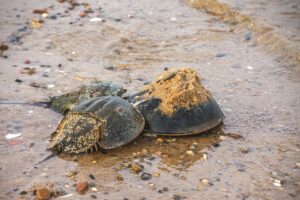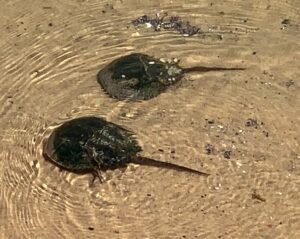There is perhaps no thornier marine management issue for regulatory bodies on the Atlantic Coast than what to do about horseshoe crabs, which are harvested as bait for the whelk fishery, but are increasingly sought for biomedical uses.
Two companies on the Cape harvest and bleed horseshoe crabs for Limulus amebocyte lysate (LAL), a valuable compound relied upon by the pharmaceutical industry for bacterial testing.
Because of the rapid growth of the medical market and the slow growth of the species — females take 10 years to reach reproductive maturity — the Mass. Marine Fisheries Advisory Commission (MFAC) is considering new horseshoe crab fishery regulations that aim to balance conservation, commercial fishing, and medical research interests.

The current rules, implemented in 2010, protect horseshoe crabs for five-day periods around each new and full Moon from April 16 to June 30, which roughly aligns with peak horseshoe crab spawning season. These lunar closures represent poor animal management practice, said Mark Faherty, the science coordinator at Mass Audubon’s Wellfleet Bay Wildlife Sanctuary.
“You don’t target spawning females,” said Faherty. “It’s just not how you would manage any wildlife, in any way, ever. It’s how you would harvest horseshoe crabs if you were trying to make them go extinct.”
The proposed regulations, submitted to MFAC by Mass. Div. of Marine Fisheries Director Daniel J. McKiernan, would institute a blanket prohibition on horseshoe crab harvesting from Jan. 1 to May 31. Because it overlaps with spring nearshore spawning season, the new closure period would largely affect hand harvesters rather than trawlers who gather the crabs at sea.
In a memo to MFAC, McKiernan said that he favored this approach not only because it protects the crabs during their peak spawning season but also because it is more enforceable than a periodic closure. He further wrote that opening harvesting in June would mean the crabs should still be accessible to both hand harvesters and trawlers.
The proposed regulations represent a “precautionary” approach, according to McKiernan, based on concern about “the potential for continued growth in the exploitation of this resource.” The hope, he said, is to cap exploitation at current levels to “capture a stock decline before it occurs.”
Cape Cod is near the northern end of the horseshoe crab’s geographic range. Most of the state’s trawl harvest occurs to the south and west in Nantucket Sound, while hand harvesters operate throughout the shores of Cape Cod Bay.
Horseshoe crab stocks are not currently collapsing here. A horseshoe crab benchmark stock assessment and report conducted by the Atlantic States Marine Fisheries Commission (ASMFC) in 2019 estimated that surveys of the Northeast region indicated “neutral” stock status for horseshoe crabs, up from “poor” since 2009. The New York region received “poor” marks in the same assessment, while the Southeast was classified as “good.”
But Faherty said improvements are not keeping pace with growing pressure on the crabs. Faherty is on the board of the Horseshoe Crab Conservation Association, a Cape-based advocacy group formed in 1998, when the Massachusetts horseshoe crab harvest was essentially unregulated. In January, the association filed an auxiliary petition to the DMF’s proposals that suggested extending the closure to June 15.
The group is still advocating for that later date.
“We think that because these animals are so vulnerable, we should be very cautious about these regulations and take the most conservative measures possible,” said Brenda Boleyn, a marine biologist and one of the founders of the association. The two additional weeks of prohibition on the crab harvest, Boleyn said, will make a big difference to the crabs and little difference to the fishery.
The proposed regulations would also update horseshoe crab dealer permits, reporting requirements, and harvest quotas, dropping the quota for the bait harvest from 165,000 to 140,000.
More important, according to Faherty, is that the biomedical harvest, which has historically faced little regulation because the bleeding process purports to be catch-and-release, would also now be limited. The proposed quota is 200,000 horseshoe crabs, distributed between the two on-Cape operators: Associates of Cape Cod and Charles River Labs, which, the Boston Globe reported, quietly set up an operation in Harwich in the summer of 2022.

It was the arrival on the Cape of Charles River Labs that created the need for tighter regulation, according to Faherty. “They are the biggest biomedical bleeding company of horseshoe crabs in the world,” he said.
The DMF proposal reported that the 2022 biomedical harvest clocked in at around 175,000. According to data analysis conducted by the ASMFC, the mortality rate of biomedical horseshoe crab bleeding is estimated at 15 percent, and bleeding has sublethal effects on horseshoe crab health.
In an emailed statement to the Independent, Sam Jorgenson, the public relations director for Charles River Labs, wrote that her company “partners closely with the Massachusetts Department of Marine Fisheries to ensure that our work on Cape Cod supports a sustainable horseshoe crab population.
“We will continue to work with federal, state and local wildlife and resource management agencies to balance humanity’s need for this valuable resource with the need to protect the crabs that provide it,” she added.
While sensitive to the DMF’s balancing act, local fishermen have concerns about the regulation’s effect on their businesses. Heather Haggerty, the owner of New Bedford-based Big G Seafood, which stores and distributes horseshoe crabs as bait throughout the Cape and Islands, said her company gets 65 percent of its bait crabs in May. She said that “with the proposed closure we will need to purchase all of our crabs from draggers,” which she said would cause significant difficulty in supply and storage and hurt her business.
Phillip Michaud Jr., a Barnstable-based trawler who has harvested horseshoe crabs for both bait and biomedical buyers in the past, said the horseshoe crab fishery is “of significant value” to his four-person boat, though he declined to give numbers.
“In my experience, there are an incredible abundance of horseshoe crabs,” said Michaud. “I understand that the DMF is under a lot of pressure to restrict further and further, but they’ve already been preemptive. I believe in conservation and cutbacks for a resource when it’s necessary, but I’m not seeing it here.”
According to Faherty, Massachusetts trails other Atlantic states in implementing horseshoe crab harvest regulations. New Jersey, for example, recently passed a temporary moratorium on harvesting female horseshoe crabs in Delaware Bay. “We’re playing catch-up,” Faherty said.
Faherty said one reason for other states’ rules is the ecological connection between horseshoe crabs and shorebirds. Red knots, in particular, depend on horseshoe crab eggs as a food source during migration. But their interdependence is less apparent in Massachusetts than in places like Delaware Bay, though it can still be observed during May and June at Monomoy Wildlife Refuge, where protected waters prevent horseshoe crabs from being harvested.
“Our point is, there could be more of this if we didn’t manage horseshoe crabs as essentially a trash species” rather than as the sought-after commodity the crabs have become, Faherty said.
The DMF is collecting written public comment on the regulations via email through May 1 at [email protected].
